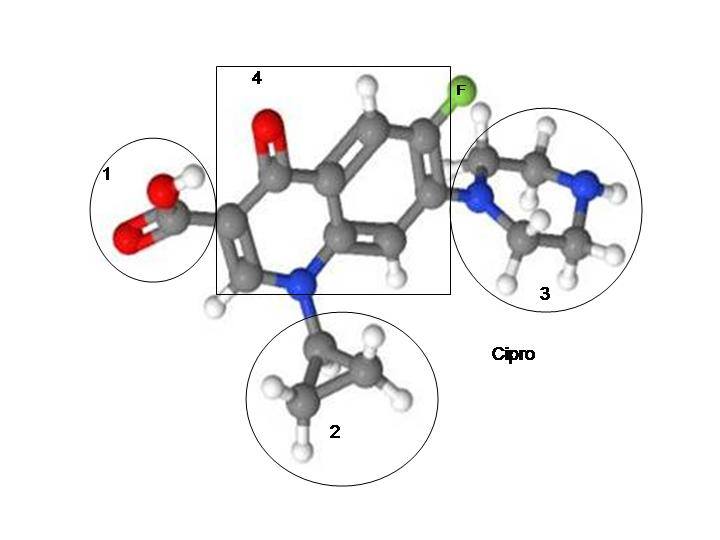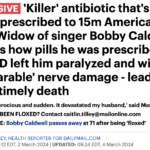
The following was written by Kim Jansen. You can read Kim’s story of fluoroquinolone toxicity HERE.
If you are interested in writing a guest-post for floxiehope.com, please let me know. Here is a post with more information about writing for floxiehope.
Here is a version of this post that is easier to read and print. It’s a great overview of fluoroquinolone toxicity to give to your loved-ones. The A to Z of Fluoroquinolone Toxicity Syndrome
The A to Z of Fluoroquinolone Toxicity Syndrome
A. Antibiotic. Fluoroquinolones are a family of broad-spectrum antibiotics that are commonly used to treat a variety of illnesses such as respiratory and urinary tract infections. Types of fluoroquinolones (along with their brand-names in brackets), include: ciprofloxacin (Cipro); levofloxacin (Levaquin); moxifloxacin (Avelox); gatifloxacin (Tequin); ofloxacin (Ocuflox/Floxin/Floxacin); norfloxacin (Noroxin). These antibiotics have serious side effects, with the term ‘fluoroquinolone toxicity syndrome’ being used to refer to the condition experienced by those who suffer from these side effects.
B. Bayer. Bayer is a pharmaceutical company that manufactures Cipro and Avelox. Bayer is currently facing a new lawsuit from a complainant, who has been diagnosed with peripheral neuropathy (see ‘Nerve Damage’ entry below) since 2011. She alleges that Bayer knew that Cipro could cause chronic or permanent peripheral neuropathy soon after receiving FDA (U.S) approval in 1987. By 1988, the drug companies possessed at least one published case report that constituted a safety “signal” that fluoroquinolones were associated peripheral nerve damage and that further investigation and study were necessary to protect patients. Since then, numerous other studies have affirmed this connection. This complainant’s Cipro lawsuit joins hundreds of other fluoroquinolone toxicity claims pending against manufacturers of fluoroquinolone antibiotics.
C. Central Nervous System Damage. Fluoroquinolones are able to penetrate the blood brain barrier, thus also able to damage a person’s central nervous system . The FDA in America acknowledged this fact and placed a warning about potential CNS damage on fluoroquinolone medication (see ‘FDA Warnings’ entry below). Some of the side effects of CNS damage include insomnia, restlessness, seizures, convulsions, and psychosis. An extensive collaborative investigation by scientists and member of a social network in 2016 found that 93 of 94 respondents of a survey reported fluoroquinolone-associated events including anxiety, depression, insomnia, panic attacks, clouded thinking, depersonalization, suicidal thoughts, psychosis, nightmares, and impaired memory beginning within days of fluoroquinolone initiation or days to months of fluoroquinolone discontinuation. They also discovered that mice treated with ciprofloxacin had lower grip strengths, reduced balance, and depressive behaviour compared with the controls.
D. DNA Damage. Fluoroquinolones work by inhibiting the replication of bacterial DNA. Tests have shown that these antibiotics also damage healthy DNA, including mitochondrial DNA. This is one of the likely reasons why the damage caused by fluoroquinolone toxicity affects multiple body systems and is persistent.
E. EMA. Public Hearing. In June 2018, the EMA (European Medicines Agency) held a public hearing to discuss the serious health concerns surrounding side effects of quinolones and fluoroquinolones. On 15 November 2018, EMA finalised a review of serious, disabling and potentially permanent side effects with quinolone and fluoroquinolone antibiotics given by mouth, injection or inhalation. The review incorporated the views of patients, healthcare professionals and academics presented at EMA’s public hearing on fluoroquinolone and quinolone antibiotics in June 2018. Here is an excerpt from the press release of their findings:
EMA’s human medicines committee (CHMP) endorsed the recommendations of EMA’s safety committee (PRAC) and concluded that the marketing authorisation of medicines containing cinoxacin, flumequine, nalidixic acid, and pipemidic acid should be suspended. The CHMP confirmed that the use of the remaining fluoroquinolone antibiotics should be restricted. In addition, the prescribing information for healthcare professionals and information for patients will describe the disabling and potentially permanent side effects and advise patients to stop treatment with a fluoroquinolone antibiotic at the first sign of a side effect involving muscles, tendons or joints and the nervous system.
F. FDA Warnings. The U.S. Food and Drug Administration has issued a series of warnings over the last number of years regarding serious and potentially permanent adverse side effects of fluoroquinolones, including a ‘Black Box’ warning (its strongest warning possible) in 2008, which it has upgraded numerous times since. A summary of the warnings is below:
a. 2008 – increased risk of tendinitis and tendon rupture.
b. 2011 – fluoroquinolones may have neuromuscular blocking activity.
c. 2013 – the potential for irreversible peripheral neuropathy (serious nerve damage).
d. 2016 – disabling and potentially permanent serious side effects that can occur together which may involve the tendons, muscles, joints, nerves, and central nervous system.
e. 2018 (July) – may cause significant decreases in blood sugar, potentially resulting in coma, as well as certain mental health side effects, including disturbances in attention, disorientation, agitation, nervousness, memory impairment, and serious disturbances in mental abilities called delirium.
f. 2018 (December) – the risk of aortic aneurysm and dissection.
Fluoroquinolones are now deemed to be a ‘drug of last resort’ in the U.S for most infections. The clinical guidelines in Australia, whilst not quite as strong, clearly indicate that fluoroquinolones should be reserved for serious bacterial infections for which an alternative treatment is not available. The reality of over-prescription and lack of physician awareness of the side effects of fluoroquinolones indicate a significant disconnect between the official regulatory bodies and current medical practice.
G. Glutathione. Glutathione is an important antioxidant. It is comprised of three amino acids (cysteine, glutamic acid, and glycine) present in most mammalian tissue. Glutathione also acts as a free radical scavenger and a detoxifying agent. A 2011 study found that the fluoroquinolone antibiotic Ciprofloxacin causes a significant decrease in glutathione levels in the body (a 25.5% decrease in levels by the fifth day of treatment.) . The reduction of glutathione in the body caused by fluoroquinolones is likely to be a contributing factor to the oxidative stress (see ‘Oxidative Stress’ entry below) caused by fluoroquinolones. Tests conducted on rats also revealed administering Ciprofloxacin resulted in a significant decrease in glutathione content in the liver.
H. Heart Damage. Due to its collagen-depleting mechanism, fluoroquinolones can cause serious damage to the heart. The U.S FDA released a warning in December 2018, stating that patients should avoid fluoroquinolone antibiotics due to an increased risk of heart-vessel tears. ‘These tears,’ it stated, ‘called aortic dissections, or ruptures of an aortic aneurysm can lead to dangerous bleeding or even death’.
I. Income loss. One of the all-too frequent associated impacts of fluoroquinolone toxicity is the sufferer’s inability to continue in paid employment. There are many media and online stories where people share the devastating impact this drug has had, not just on their health, but on their family relationships, their livelihood and their ability to be financially independent. One such news story is footnoted here.
J. Johnson & Johnson. Johnson & Johnson’s Janssen Pharmaceuticals unit discontinued production of the fluoroquinolone antibiotic Levaquin in December 2017, amid growing concerns over the serious side effects and complications potentially associated with the use of fluoroquinolone antibiotics. Another likely reason for this discontinuation by Johnson & Johnson is due to its having lost millions of dollars in previous lawsuits over Levaquin, (including settling 845 lawsuits over Levaquin in 2012) . There are still hundreds of individuals waiting to have their cases heard over debilitating injuries caused by Levaquin and other fluoroquinolones, which is another likely reason for Johnson & Johnson’s decision. Johnson & Johnson’s decision to cease manufacturing this drug does not constitute a product recall, with the drug still being available with the J&J brand until 2020 and generic versions of the drug continuing indefinitely at this stage.
K. Kidney Damage. Fluoroquinolone antibiotics can cause kidney damage including renal failure. A 2013 study found a twofold increased risk of acute kidney injury requiring hospital admission with the use of fluoroquinolone antibiotics among adult men.
L. Levaquin. Levaquin is the brand name of a type of fluoroquinolone antibiotic manufactured by Janssen Pharmaceutical (see ‘Johnson & Johnson’ entry above). The drug’s scientific name is levofloxacin. Levaquin has been the subject of hundreds of lawsuits by patients who have suffered debilitating side effects from this drug.
M. Mitochondrial Toxicity. The mitochondria are rod-shaped organelles that are the ‘power generators’ of cells, ‘turning sugars, fats and proteins that we eat, into forms of chemical energy that the body can use to carry on living’. Fluoroquinolones damage mitochondrial DNA, resulting in a range of disabling symptoms in sufferers, including pain, weakness and fatigue.
N. Nerve Damage. Many sufferers of fluoroquinolone toxicity syndrome experience nerve damage, often resulting in peripheral neuropathy. Peripheral neuropathy is a condition in which the nerves in the peripheral nervous system become damaged. Usually the disorder affects the nerves that provide sensation, which causes pain, tingling, and burning symptoms of the nerves affected, frequently, but not limited to, the hands and feet. The U.S. Food and Drug Administration enhanced its warnings of fluoroquinolone side effects in 2013 to include ‘the potential for irreversible peripheral neuropathy’.
O. Oxidative Stress. ‘Oxidative stress occurs when excess oxygen radicals are produced in cells, which could overwhelm the normal antioxidant capacity. [Oxidative stress can lead to damage of] proteins, lipids, and DNA, which could lead to cytotoxicity, genotoxicity, and even carcinogenesis when damaged (mutated) cells can proliferate.’ A scientific study conducted in 2011 demonstrated that fluoroquinolone antibiotics are a significant cause of oxidative stress, with tests revealing this stress was ‘greatest 5 days after exposure to ciprofloxacin and levofloxacin therapy, which indicates the formation of reactive oxygen species as in previous studies with fluoroquinolones. These results [were] further supported by [a] decrease in plasma antioxidant status by 77.6% and 50.5% for ciprofloxacin and levofloxacin respectively’24. They concluded their report with the finding that ‘[t]here was a considerable increase in lipid peroxide levels indicating an enormous oxidative stress’ in patients taking fluoroquinolones and suggested that increase in oxidative stress may be responsible for the pathological mechanism of tendinitis (see ‘Tendon Ruptures’ entry below).
P. Pain. Pain is often (but not always) the first symptom fluoroquinolone toxicity sufferers experience. This can occur after the first dose taken. The pain usually begins in the legs or feet before spreading to other parts of the body. The pain will often be constant and remain for months or years. Pain in joints, hands, feet, tendons and nerves (see ‘Nerve Damage’ entry above) is common, ranging in severity from a dull ache to, extreme, sharp, unbearable pain. Many case studies document patients living with extreme, ongoing pain that cannot be medically managed.
Q. Quinolones. Quinolones are an earlier generation of the current fluoroquinolone family of antibiotics (although quinolones are still in limited use). A fluorine atom was added to the quinolone’s central ring system, thus creating fluoroquinolones, which have proven to be more effective in disrupting bacterial DNA than the quinolone form of the antibiotic.
R. Relapse. Many sufferers of fluoroquinolone toxicity syndrome report (often multiple) relapses of their symptoms, sometimes years after the initial onset of their illness. This is likely due to the multi-system, cellular and oxidative-stress nature of this toxicity. Sometimes a relapse can be caused by a specific trigger, such as the subsequent use of NSAIDs (such as ibuprofen) or steroid medications.
S. Suicide. There have been thousands of reported cases of deaths linked to fluoroquinolone toxicity (over 6500 to the end of 2015 in the U.S alone). This number, however, does not include the large number of people who have taken their own lives after experiencing sudden and extreme mental health side effects from fluoroquinolones. A group of doctors wrote an article for the European Journal of Internal Medicine in which they report on the concerning number of suicides or attempted suicides by patients on fluoroquinolone antibiotics. They cite that in the United States, 40% of reported fluoroquinolone-related suicide events occurred within two weeks of taking fluoroquinolone medication. Many of these patients had no previous mental health issues.
T. Tendon Ruptures/Tendonitis. One of the most common adverse side effects of fluoroquinolones is tendon damage, including tendon ruptures, frequently to the Achilles tendon. This is due to a combination of factors, including fluoroquinolones being responsible for destroying collagen (collagen is a major component of tendons). A study in 2015 investigated the impact of fluoroquinolones on collagen and discovered that fluoroquinolones ‘were associated with almost a tripling of the risk of tendon ruptures—a recognised collagen-associated adverse event induced by these medications.’ Perhaps of even greater concern was their finding that ‘fluoroquinolones were associated with a similar increase in the risk of aortic aneurysms.’
U. Under-reporting. It is almost certain that fluoroquinolone toxicity is under-reported. Drug safety professionals estimate that only 10% of adverse events (across all drugs) are reported to the FDA every year, in part due to physicians having no requirement or incentive to report adverse reactions. It is highly likely that the rate of adverse reaction reporting for fluoroquinolone antibiotics is lower still, for the following reasons:
a. The noticeable symptoms of fluoroquinolone toxicity can take months to manifest, thus making it more likely that the patient does not connect their ‘new’ symptoms with a course of fluoroquinolone antibiotics they took previously.
b. Many medical practitioners are still unaware of, or refuse to acknowledge, the damage that fluoroquinolone antibiotics can cause. This is evidenced in the frequency with which these antibiotics are prescribed for uncomplicated (suspected) infections when safer alternatives are available. As one report states: ‘Despite these seemingly significant numbers and overwhelming reports from patients, physicians continue to prescribe fluoroquinolone antibiotics unsystematically, against US Food and Drug Administration recommendations. Thus, adverse reactions to fluoroquinolones are often not reported by physicians, nor by the patient themselves. Even though significant under-reporting is extremely likely, there are over 200,000 reported cases of adverse reactions to fluoroquinolone antibiotics in the U.S alone, tens of thousands of these being serious and over 6,000 reported deaths. 1,498 cases of adverse reactions to Ciprofloxacin have been submitted to Australia’s Therapeutic Goods Administration (up to 18 January 2019).
V. Vitamins and Minerals. There is no quick cure or treatment for fluoroquinolone toxicity. Healing plans usually focus on rest and a diet/supplement regime which aims to replenish those essential elements that have been depleted or damaged by the drug. One of the most important mineral supplements is magnesium. This is because fluoroquinolones deplete magnesium from the body and also because toxicity from fluoroquinolones is reduced by the supplementation of magnesium (as proven through tests conducted on both humans and rats).
W. Weakness and Fatigue. Alongside pain, muscle weakness and fatigue are often the first symptoms fluoroquinolone toxicity sufferers experience. The weakness is likely a result of the cellular damage caused by the drug, including damage to the mitochondria in the cells (see ‘Mitochondrial Toxicity’ entry above). As a consequence, many sufferers are (mis)diagnosed with CFS/ME (Chronic Fatigue Syndrome/ Myalgic Encephalomyelitis).
X. The X Factor (the unknowns). Scientists and medical professionals are still discovering all the ways in which fluoroquinolones adversely affect the body and mind. Much is still unknown about the long-term impacts of this drug. One of the more frightening discoveries in recent years is the likelihood that fluoroquinolone toxicity sufferers are at a significantly higher risk of developing Parkinson’s Disease and Alzheimer’s due to the long-term oxidative stress caused by this drug and by the damage it causes to the cells’ mitochondria (see ‘Oxidative Stress’ and ‘Mitochondrial Toxicity’ entries above). In 2014, A U.S. medical practitioner, Charles Bennett, who has conducted a great deal of research on fluoroquinolone toxicity, filed a citizen’s petition with the FDA seeking to expand the black box warning to include mitochondrial toxicity as one of its side effects, with the concern that it can lead to Parkinson’s Disease and Alzheimer’s.
Y. Years. People who suffer from fluoroquinolone toxicity often take years to recover, whilst others experience little improvement in their symptoms, even years after first suffering toxicity (as evidenced by some of the speakers at the EMA public hearing in June 2018).
Z. ZZZZ (sleep). The European Medicines Agency’s 2018 public hearing and investigation into fluoroquinolones concluded that sleep problems (including nightmares and insomnia) were among the many long-term side effects of fluoroquinolone toxicity. Sadly, much of the medical profession world-wide seems to have no trouble being asleep to the dangers of fluoroquinolones, with doctors continuing to prescribe this drug in the millions each year for uncomplicated health conditions where safer, as effective antibiotics are available. Patients also continue to report having been prescribed fluoroquinolones without being given any information about the risk of serious, potentially permanent, side effects.
References:
- The Marshall Protocol Knowledge Base. “Fluoroquinolone Antibiotics”: https://mpkb.org/home/othertreatments/antibacterials/fluoroquinolones
- Arentz Law Group. “Cipro Lawsuit Alleges Bayer Actively Concealed Irreversible Peripheral Neuropathy Risks.” https://arentzlaw.com/defective-drug/cipro-lawsuit-peripheral-neuropathy/
- Dr Joseph Mercola. “Antibiotic Alert: The Drug the Doctor Ordered Could Cause Deadly Side Effects.”
https://articles.mercola.com/sites/articles/archive/2012/10/20/fluoroquinolones-side-effects.aspx - Oncology Practice. “Fluoroquinolone-related neuropsychiatric and mitochondrial toxicity: a collaborative investigation by scientists and members of a social network.” https://www.ncbi.nlm.nih.gov/pubmed/26955658
- Nucleic Acids Research. “Ciprofloxacin impairs mitochondrial DNA replication initiation through inhibition of Topoisomerase-2.” https://academic.oup.com/nar/article/46/18/9625/5088042
- European Medicines Agency. “Quinolone- and fluoroquinolone-containing medicinal products – European Commission Final Decision.” https://www.ema.europa.eu/en/medicines/human/referrals/
quinolone-fluoroquinolone-containing-medicinal-products - FDA Drug Safety Communication. “FDA updates warnings for oral and injectable fluoroquinolone antibiotics due to disabling side effects.” https://www.fda.gov/drugs/drugsafety/ucm511530.htm
- U.S. Food and Drug Administration. “FDA advises restricting fluoroquinolone antibiotic use for certain uncomplicated infections”. https://www.fda.gov/Drugs/DrugSafety/ucm500143.htm
- U.S National Library of Medicine. “Glutathione.” https://pubchem.ncbi.nlm.nih.gov/compound/glutathione
- Journal of Young Pharmacists. “Oxidative Stress Induced by Fluoroquinolones on Treatment for Complicated Urinary Tract Infections in Indian Patients.” https://www.ncbi.nlm.nih.gov/pmc/articles/PMC3249743/
- Drug and Chemical Toxicology. “Ciprofloxacin‐Induced Glutathione Redox Status Alterations in Rat Tissues.” https://www.tandfonline.com/doi/abs/10.1081/DCT-120037504?journalCode=idct20
- Medical Xpress. “Certain antibiotics tied to deadly heart vessel tears: FDA.”
https://medicalxpress.com/news/2018-12-antibiotics-tied-deadly-heart-vessel.html - Al Jazeera. “Left paralysed from Fluoroquinolone antibiotic toxicity.”
https://www.aljazeera.com/indepth/features/2017/09/left-paralysed-fluoroquinolone-antibiotic-toxicity-170919135407632.html - RX Injury Help. “Janssen Discontinued Levaquin Production as Concerns Over Fluoroquinolone Side Effects Grow.” https://www.rxinjuryhelp.com/news/2018/07/18/janssen-discontinued-levaquin-production-as-concerns-over-fluoroquinolone-side-effects-grew/
- Drug Injury Law: Medical and Legal Information. “Johnson & Johnson settles 845 Levaquin Lawsuits.” https://www.drug-injury.com/drug_injury/2012/11/johnson-johnson-settles-845-levaquin-lawsuits.html
- Arentz Law Group. “Levaquin pulled from market to avoid lawsuit.”
https://arentzlaw.com/defective-drug/jj-stops-levaquin-sales/ - Canadian Medical Association Journal. “Risk of acute kidney injury associated with the use of fluoroquinolones.” https://www.ncbi.nlm.nih.gov/pmc/articles/PMC3708027/
- Thomas J Henry Law. “Johnson & Johnson Settles Levaquin Lawsuits”. https://thomasjhenrylaw.com/blog/dangerous-drugs-devices/johnson-johnson-settles-levaquin-lawsuits/
- Mitochondrial Biology Unit. http://www.mrc-mbu.cam.ac.uk/what-are-mitochondria
- Oncology Practice. “Fluoroquinolone-related neuropsychiatric and mitochondrial toxicity: a collaborative investigation by scientists and members of a social network.” https://www.mdedge.com/hematology-oncology/article/106661/patient-survivor-care/fluoroquinolone-related-neuropsychiatric
- Journal of Investigative Medicines: “Permanent Peripheral Neuropathy: A Case Report on a Rare but Serious Debilitating Side-Effect of Fluoroquinolone Administration.” https://www.ncbi.nlm.nih.gov/pmc/articles/PMC4528905/
- Medicine Net. “Peripheral Neuropathy Causes, Symptoms, and Treatment Medications.” https://www.medicinenet.com/peripheral_neuropathy/article.htm#peripheral_neuropathy_definition_and_facts
- Science Direct. “Oxidative Stress.” https://www.sciencedirect.com/topics/neuroscience/oxidative-stress
- Journal of Young Pharmacists: “Oxidative Stress Induced by Fluoroquinolones on Treatment for Complicated Urinary Tract Infections in Indian Patients.” https://www.ncbi.nlm.nih.gov/pmc/articles/PMC3249743/
- Journal of Pain & Palliative Care Pharmacotherapy. “Intractable Acute Pain Related to Fluoroquinolone-Induced Peripheral Neuropathy.” https://www.ncbi.nlm.nih.gov/pubmed/28358229
- US National Library of Medicine. “Fluoroquinolone-induced serious, persistent, multisymptom adverse effects.” https://www.ncbi.nlm.nih.gov/pmc/articles/PMC4600819/
- US National Library of Medicine. “Fluoroquinolones interactions with nonsteroidal anti-inflammatory drugs.” https://www.ncbi.nlm.nih.gov/pubmed/15176310
- European Medicines Agency. “EMA public hearing on quinolones and fluoroquinolones.” https://www.ema.europa.eu/en/documents/other/public-hearing-quinolone-fluoroquinolone-written-interventions_en.pdf
- Nature. “When antibiotics turn toxic.” https://www.nature.com/articles/d41586-018-03267-5
- European Journal of Internal Medicine. “Fluoroquinolone-associated suicide.” https://www.ejinme.com/article/S0953-6205(18)30284-X/fulltext
- The Journal of Clinical and Aesthetic Dermatology. “The Risk of Fluoroquinolone-induced Tendinopathy and Tendon Rupture.” https://www.ncbi.nlm.nih.gov/pmc/articles/PMC2921747/
- BMJ Journals. “Fluoroquinolones and collagen associated severe adverse events: a longitudinal cohort study.” https://bmjopen.bmj.com/content/5/11/e010077
- PSQH: Patient Safety and Quality Healthcare. “A Closer Look at FDA’s Adverse Event Reporting System.” https://www.psqh.com/analysis/a-closer-look-at-fdas-adverse-event-reporting-system/
- Oxidative Medicine and Cellular Longevity. “Treatment of the Fluoroquinolone-Associated Disability: The Pathobiochemical Implications.” https://www.ncbi.nlm.nih.gov/pmc/articles/PMC5632915/
- Journal of Investigative Medicine. “Permanent Peripheral Neuropathy: A Case Report on a Rare but Serious Debilitating Side-Effect of Fluoroquinolone Administration.” https://www.ncbi.nlm.nih.gov/pmc/articles/PMC4528905/
- Therapeutic Goods Administration (Australia) Database of Adverse Event Notifications – medicines https://apps.tga.gov.au/PROD/DAEN/daen-report.aspx
- American Society for Microbiology. “Diminished Ciprofloxacin-Induced Chondrotoxicity by Supplementation with Magnesium and Vitamin E in Immature Rats.” https://www.ncbi.nlm.nih.gov/pmc/articles/PMC1803142/
- ME Association UK. “Update: MHRA issues new restrictions and precautions for Fluoroquinolone antibiotics 29 March.” https://www.meassociation.org.uk/2019/03/update-mhra-restrictions-and-precautions-for-fluoroquinolone-antibiotics-28-march-2019/
- CBS Chicago. “Safety Advocate: Powerful Antibiotics Being Overprescribed.”
https://chicago.cbslocal.com/2015/03/11/safety-advocate-powerful-antibiotics-being-overprescribed/ - European Medicines Agency. “Public Hearing on quinolone and fluoroquinolone antibiotics” .
https://www.youtube.com/watch?v=1vao8o5NGUc - European Medicines Agency. “Disabling and potentially permanent side effects lead to suspension or restrictions of quinolone and fluoroquinolone antibiotics.” https://www.ema.europa.eu/en/news/disabling-potentially-permanent-side-effects-lead-suspension-restrictions-quinolone-fluoroquinolone
******











… [Trackback]
[…] Here you can find 8506 additional Information to that Topic: floxiehope.com/the-a-to-z-of-fluoroquinolone-toxicity-syndrome/ […]
… [Trackback]
[…] Find More Info here to that Topic: floxiehope.com/the-a-to-z-of-fluoroquinolone-toxicity-syndrome/ […]
… [Trackback]
[…] Info to that Topic: floxiehope.com/the-a-to-z-of-fluoroquinolone-toxicity-syndrome/ […]
… [Trackback]
[…] Find More Info here on that Topic: floxiehope.com/the-a-to-z-of-fluoroquinolone-toxicity-syndrome/ […]
… [Trackback]
[…] Find More Information here to that Topic: floxiehope.com/the-a-to-z-of-fluoroquinolone-toxicity-syndrome/ […]
… [Trackback]
[…] Find More to that Topic: floxiehope.com/the-a-to-z-of-fluoroquinolone-toxicity-syndrome/ […]
… [Trackback]
[…] Find More on on that Topic: floxiehope.com/the-a-to-z-of-fluoroquinolone-toxicity-syndrome/ […]
… [Trackback]
[…] Here you will find 80605 more Information on that Topic: floxiehope.com/the-a-to-z-of-fluoroquinolone-toxicity-syndrome/ […]
… [Trackback]
[…] Read More on that Topic: floxiehope.com/the-a-to-z-of-fluoroquinolone-toxicity-syndrome/ […]
… [Trackback]
[…] Find More here to that Topic: floxiehope.com/the-a-to-z-of-fluoroquinolone-toxicity-syndrome/ […]
… [Trackback]
[…] Read More on that Topic: floxiehope.com/the-a-to-z-of-fluoroquinolone-toxicity-syndrome/ […]
… [Trackback]
[…] Here you can find 72735 more Information to that Topic: floxiehope.com/the-a-to-z-of-fluoroquinolone-toxicity-syndrome/ […]
… [Trackback]
[…] Here you will find 8320 additional Info to that Topic: floxiehope.com/the-a-to-z-of-fluoroquinolone-toxicity-syndrome/ […]
… [Trackback]
[…] Find More on on that Topic: floxiehope.com/the-a-to-z-of-fluoroquinolone-toxicity-syndrome/ […]
… [Trackback]
[…] Read More Information here to that Topic: floxiehope.com/the-a-to-z-of-fluoroquinolone-toxicity-syndrome/ […]